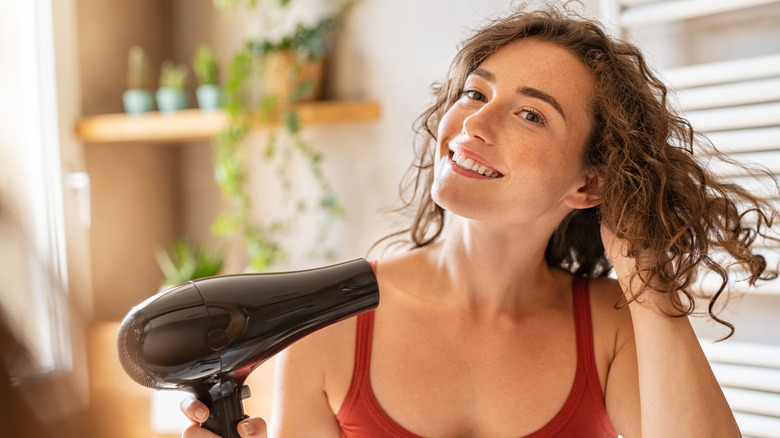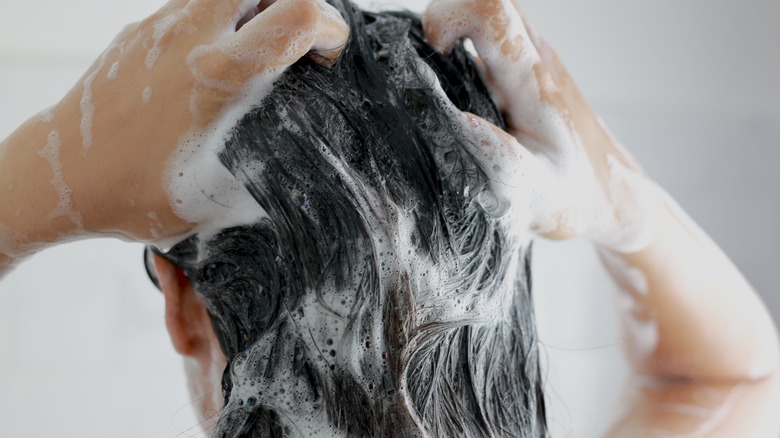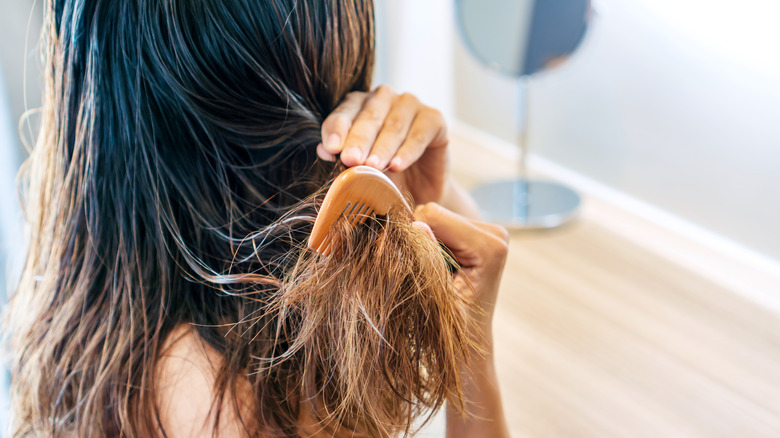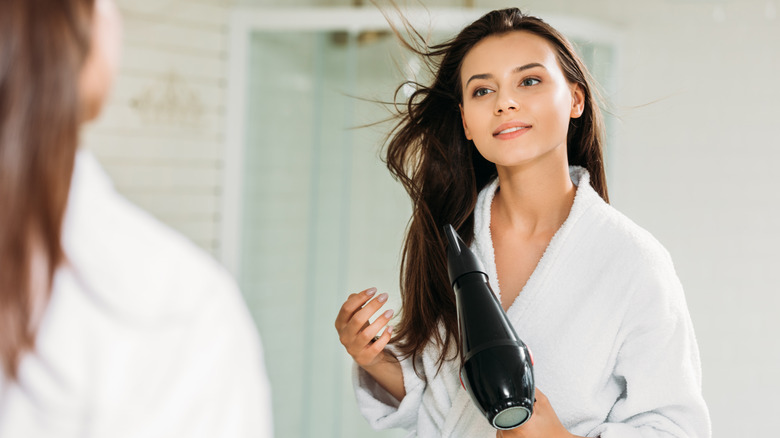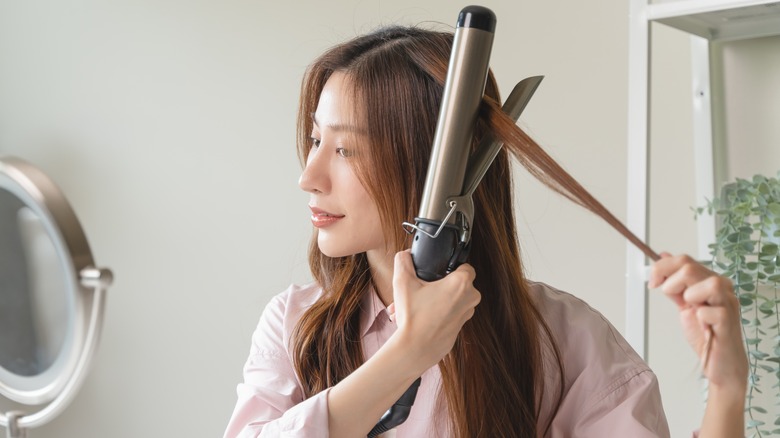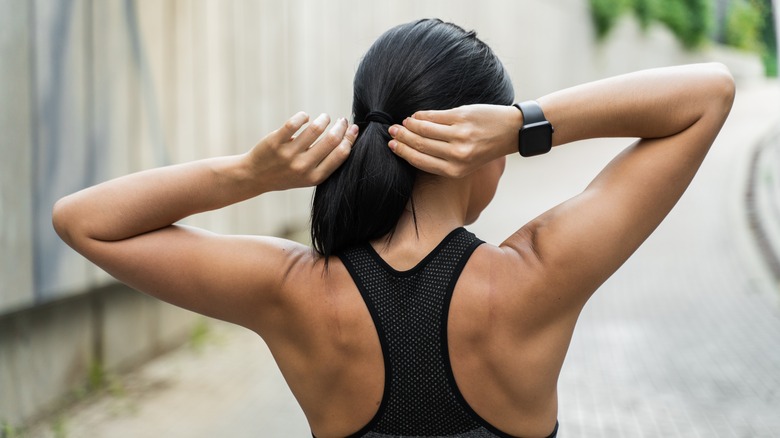6 Damaging Mistakes You're Probably Guilty Of Making With Wet Hair
You already know that bleach and hot tools are bad for your locks, but water can also be a common enemy of healthy hair. Simply put, exposing your tresses to water makes them more susceptible to damage. This is because the proteins of the hair change when wet, forming weaker bonds that make the cuticles easier to stretch, lift, and break. And unfortunately, that damage sticks around even after your strands have dried.
However, your hair has to get wet sometimes, like when sudsing up in the shower. Limiting washes to a couple of times a week (a strategy that many hair experts recommend, per WebMD) is one way to minimize damage, but on the days you ditch your shower cap, your hair is still vulnerable to breakage. And besides showering, there are other instances where your hair may get wet, like during a day at the pool or if you're caught in the rain without an umbrella.
So how can you keep your hair protected, even in its weakest state? Here are six wet hair mistakes that could be wrecking your mane — and what you should do instead to limit hair damage.
Washing your hair the wrong way
The most common reason for making your hair wet in the first place is to wash it. According to the Centers for Disease Control and Prevention, cleansing your hair and scalp is essential to remove oil buildup and stave off skin infections. However, doing it the wrong way could lead to more damage. First, start by dialing down the scalding hot water. "When hot water is used to wash hair, your hair follicles are exposed to environmental and oxidative damage, which can lead to hair fall," dermatologist Hasan Benar told Byrdie. "Hair fall accelerates due to the loosened grip of the damaged hair roots. This can also result in premature greying."
After switching to lukewarm water, check your shampoo for sulfates. Sulfates can dry out the hair, especially if you're already prone to frizz or damage, per Medical News Today. A natural, sulfate-free formula will still clean your tresses without causing dullness.
Finally, only apply your shampoo where it's truly needed. "The truth is that you have to focus on shampooing your scalp, rather than the ends of your hair," Monica Davis, a professional hairstylist, shared with Healthline. "Apply shampoo only onto the scalp, and let it clean the rest of the hair when you rinse it out."
Towel-drying delicate hair
Since wet hair is especially vulnerable to damage, you may try to dry it as quickly as possible using a rough bath towel. Unfortunately, this is a bad move for your delicate locks. Hair care brand Schwarzkopf explains that rubbing and twisting your hair with a standard cotton towel can lead to frizz and breakage. A better method for drying sopping-wet hair is to use a gentle microfiber towel or even an old t-shirt. Then, pat — don't rub! — your hair to absorb excess water. If your hair is still dripping, you can cover the hair with a towel and lightly squeeze any remaining water out.
If you prefer to wrap your hair after stepping out of the shower, don your towel turban as usual, but don't leave it on for too long. Britta Cox, founder of microfiber towel brand Aquis, told Byrdie that it's best to "let the hair towel absorb additional water for 10 to 15 minutes depending on the type of hair — fine hair will require less time while thick or curly hair will require more. This causes the least amount of friction and allows hair to dry quickly without damaging the cuticles."
Ripping through tangles
Detangling your hair when it's wet may seem easier than when it's dry, but that might be because your delicate hair is ripping instead of snagging as you glide your brush through it. The result: frizz, split ends, and other signs of damage. Depending on your hair type, it may be best to skip the brush and comb altogether while your locks are still damp. "I don't believe in brushing is always necessary," Shab Reslan, a certified trichologist and hair expert, revealed to Byrdie. "Instead, the focus should be not to tangle your hair in the shower when you're shampooing and conditioning."
If you must detangle post-shower, it's crucial to have the right tools. A wet brush with flexible bristles and a wide-toothed comb are two options that are less likely to yank wet hair compared to traditional brushes. Work through tangles from the bottom half of your hair first, as opposed to the roots — when you pull your brush or comb down from the top of your head all the way to your ends, you're more likely to create new knots, causing more damage to your tresses.
Blow-drying incorrectly
A blow-dryer can be your best friend when it comes to zapping away moisture, but the way you use it could be harming your hair. Unsurprisingly, a 2011 study published in Annals of Dermatology concluded that, like other types of heat, hair dryers damage tresses. However, the researchers found that some damage can be mitigated by choosing a lower heat setting and maintaining a distance of at least 15 centimeters between the dryer and your mane. It's also important to continuously move the dryer, rather than blasting one spot at a time.
If you're worried that gentle, low-heat blow-drying will take too long, experts suggest waiting until hair is barely damp to pull out the dryer anyway. "Get as much moisture out as you can with a towel, and let your hair air-dry for 10 to 15 minutes after you towel-dry," Becca Sible, educator for professional hair care brand Amika, told The Healthy. Then, finish off with a quick blow-dry.
Styling with straighteners and curling irons
PSA: Your hair is not meant to sizzle. Putting hot straighteners, curling irons, and other heated tools directly on wet hair is a surefire way to seriously damage your locks. "All that heat will pretty much boil the water on your hair — you're basically cooking your hair. Not something you want to do," hair expert Siobhán Quinlan explained to Real Simple. Not only that, but your hair is less likely to hold the shape you're going for when it's styled wet. The only time straighteners and curling irons belong in your hair care routine is when your tresses are completely dry.
Thankfully, the internet is overflowing with wet-hair hacks to help you style your mane without harmful heat. For curly or wavy hair, try the viral leggings curls method. For a smooth and straight look, sans straightener, try wet-setting your hair. And if you're in a hurry and decide to use a hot blow-dryer for a voluminous blowout effect, be sure to at least use a heat protectant to lock in moisture.
Using rubber bands and hair ties
Hair ties and rubber bands could be causing your hair damage, especially if you use them when your hair is still wet. "People believe they're helping their hair by putting it up while it's wet to avoid using heat, but your hair is at its most fragile when it's wet," celebrity hairstylist Laura Polko stated to Harper's Bazaar. "If you're tying your hair back tight while it's wet, you might run into more breakage."
Hair ties and rubber bands cause friction and essentially chip away at the hair cuticle in the isolated area where the elastic is placed. If you routinely tie your hair up after showering or swimming, you'll likely notice fraying and frizz right where your ponytail or bun sits on your head.
Luckily, the claw clip trend is a safer alternative for vulnerable strands. Just be sure to avoid twisting or pulling wet hair while putting it up to reduce wear and tear.
